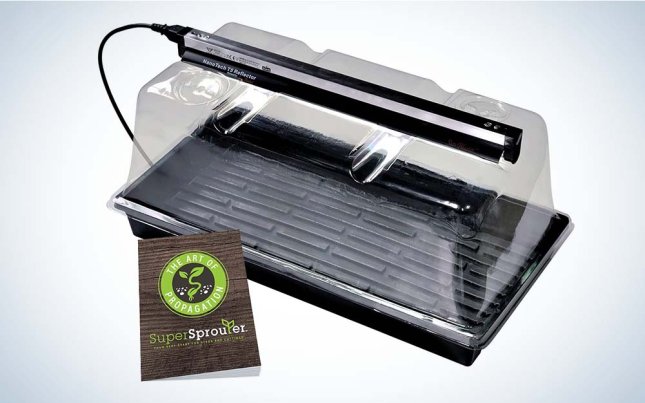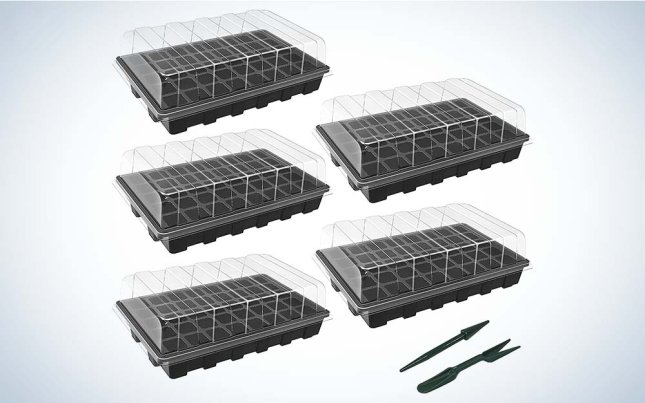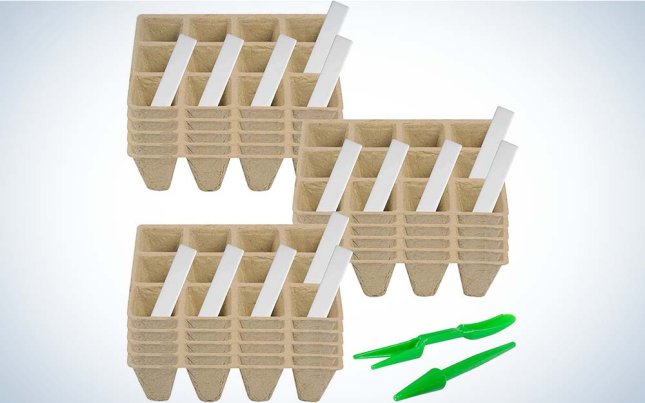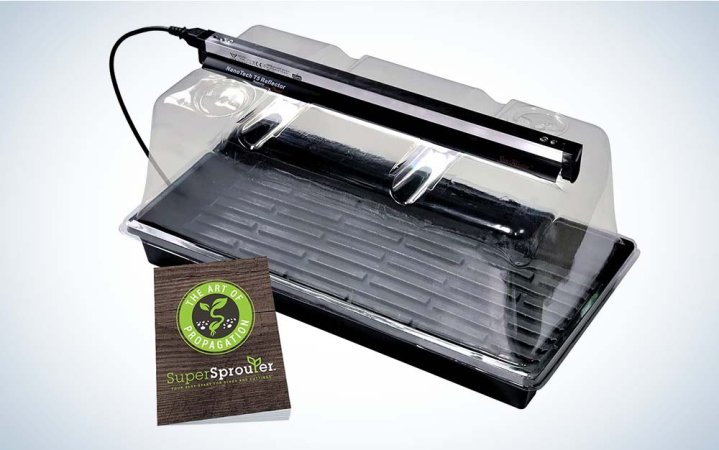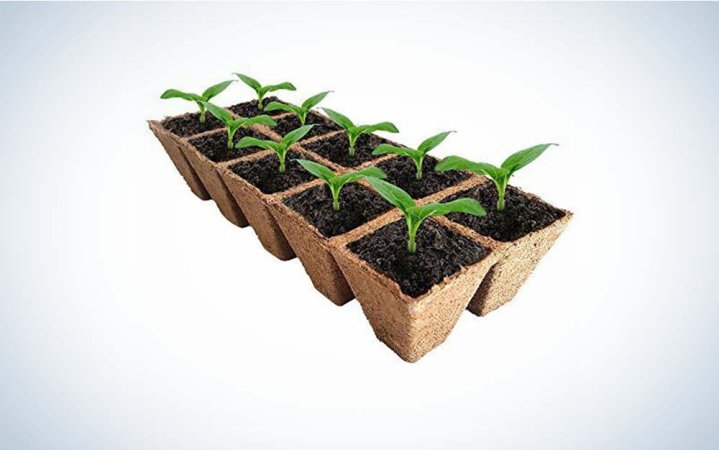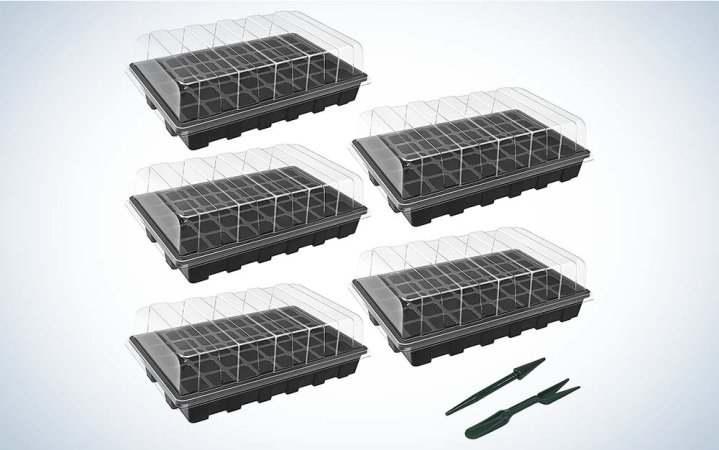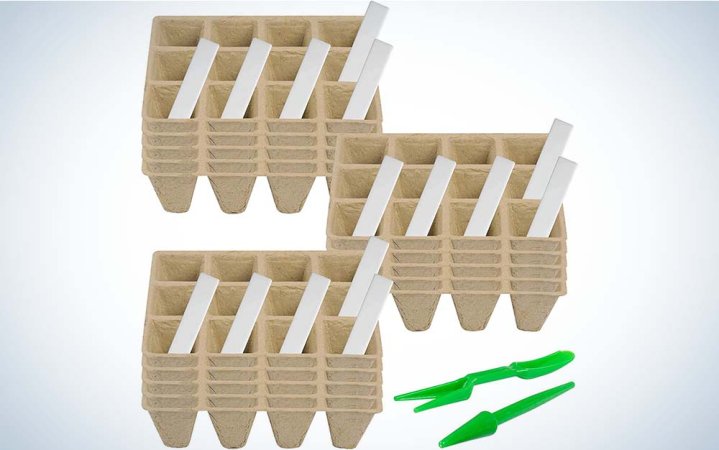We may earn revenue from the products available on this page and participate in affiliate programs. Learn more ›
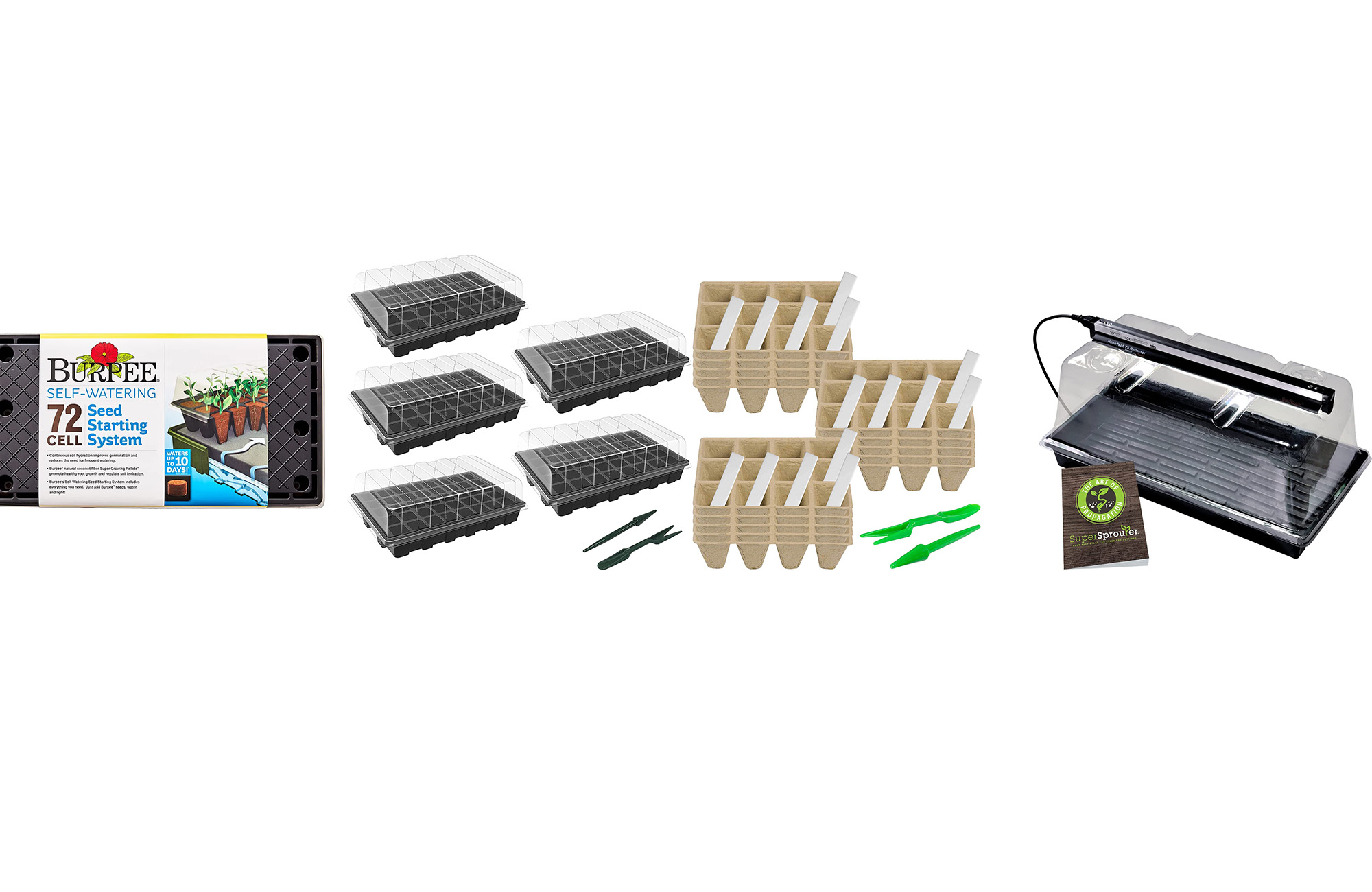
When planning a garden, seedling starter trays are a smart way to get an early start on the growing season. Simply dropping some seeds into the garden often isn’t an effective way to ensure that the seeds will grow. In fact, planting seeds in an outdoor garden often leads to them being eaten by insects, rodents, and other pests. Instead, start your seeds in a safe, controlled starter tray that can be kept indoors until the seedlings are ready to be transplanted into the garden. The trays come with humidity domes, watering mats, and base trays to help improve the chances of your seeds germinating without putting them at risk of being eaten by scavengers. Keep reading to learn how to choose the best seedling starter trays for your next home grow.
- Best overall: Super Sprouter Deluxe Propagation Kit
- Best biodegradable: JOLLY GROW Seed Starter Peat Pots Kit
- Best with dome: Gardzen 5-Set Garden Propagator Set
- Best with watering mat: Burpee Seed Starter Tray
- Best budget: Mhonniwa 180-Cell Seed Starter Tray
How we chose the best seedling starter trays
My years of home gardening experience helped me understand what works and what doesn’t work regarding seed germination and seedling growth. This experience, combined with extensive research of more than 40 different products, is the basis for this selection. I concentrated on the material, dimensions, and capacity of the seedling starter trays.
There are several different materials used to make these trays, and each one has a different but equal benefit. I chose top products from each material category, including biodegradable, disposable plastic, and reusable plastic. I also took into consideration the dimensions as well as the capacity of the seedling starter trays to determine how many plants could be grown at one time without choking out nearby seedlings. Additionally, any product with extra features that improved the germination, sprouting, or growth period superior to similar products that lacked these added benefits got extra weight in making my selections.
The best seedling starter trays: Reviews & Recommendations
Whether you’re just getting started with planting, overseeing a kids’ project, establishing seedlings for a greenhouse, or have lots of garden tools ready to go, we’ve rounded up the best options for taking that first step.
Best overall: Super Sprouter Deluxe Propagation Kit
Best overall
Super Sprouter Deluxe Propagation Kit
Pros
- Comes with a grow light and humidity dome
- Reusable for multiple home grows
- The tray fits most standard inserts and plug trays
Cons
- Does not include a plug tray with individual cells
Why it made the cut: Use the built-in grow light and humidity dome to germinate, sprout, and grow plants efficiently.
Specs
- Capacity: Variable up to 72 cells
- Material: Reusable plastic
- Dimensions: 10 x 20 inches
Our best overall pick can help ensure the seeds germinate and sprout quickly. The Super Sprouter Deluxe Propagation Kit has a humidity dome to help control the humidity level during germination. The seedling starter tray measures 10 inches by 20 inches, allowing it to be used with most standard inserts and plug trays. Though it should be noted that while this product can accommodate a tray with up to 72 cells, it does not come with a plug tray. Instead, the seedling starter set comprises a reusable plastic base tray to collect excess water, a humidity dome, and a grow light to provide even lighting to the plants.
The grow light is designed to sit in a track on top of the humidity dome, where it can shine down on the entire tray. This comprehensive kit is an excellent option for a beginner because it provides the user with all of the basic supplies to start growing their plants in the comfort of the kitchen, living room, den, or even the bedroom.
Best biodegradable: JOLLY GROW Seed Starter Peat Pots Kit
Best biodegradable
JOLLY GROW Seed Starter Peat Pots Kit
Pros
- Biodegradable cells are easy to transplant
- Environmentally friendly option for home gardening
- Five 10-cell trays with plastic plant markers/labels
Cons
- Water permeable
- Doesn’t come with a base tray
Why it made the cut: Ensure that the roots, stem, and leaves are undamaged by poor transplantation with this biodegradable starter tray that can be planted directly into the garden.
Specs
- Capacity: 50 cells
- Material: Biodegradable peat pots
- Dimensions: 10 x 4 inches
One of the main benefits of using a biodegradable seedling starter tray is that the seedlings do not need to be removed from the cells. This makes it simple to break apart the cells and plant them individually in the garden without worrying about damaging the seedling in an attempt to remove them from a plastic tray. Once the biodegradable peat cells are buried, they will begin to break down, and the roots of the seedlings will have no issue piercing through the peat walls and spreading into the soil.
The JOLLY GROW Seed Starter Peat Pots Kit comes with five trays that each have 10 cells for a total capacity of 50 cells. Each tray measures 4 inches by 10 inches and also includes plastic plant markers so that the cells can be labeled with the plant’s name. Remember that the biodegradable cells, while great for the environment, are water-permeable, so it’s advised to have a non-permeable base tray to collect excess water that drains from the soil.
Best with dome: Gardzen 5-Set Garden Propagator Set
Best with dome
Gardzen 5-Set Garden Propagator Set
Pros
- Five seedling starter trays with humidity domes
- Reusable for multiple home grows
- Uses seedling paper instead of soil
Cons
- Not biodegradable
Why it made the cut: Control the humidity level inside each of these five seedling starter trays using the included domes.
Specs
- Capacity: 200 cells
- Material: Reusable plastic
- Dimensions: 9 x 14.5 inches
In contrast to other seedling starter trays, the Gardzen 5-Set Garden Propagator Set does not require soil pods to help seeds germinate and sprout. Instead, these seedling starter trays consist of a seed tray with a drainage hold to prevent overwatering; a base tray for hydroponic gardening; and a humidity dome to encourage growth. You can also place the trays on a heating mat for extra warmth.
Each tray is made of reusable plastic and measures 9 inches by 14.5 inches. The set also comes with a dibber and a widger for easy planting. Each of the 40 cells is 1.4 inches square, which makes the trays ideal for early-season pepper and vine and smaller plants, such as cabbage, kale, and broccoli. (The company also makes 15-cell and 70-cell versions for different sizes of seedlings.)
Best with watering mat: Burpee Seed Starter Tray
Best with watering mat
Burpee See Starter Tray
Pros
- Comes with a watering mat for automatic watering
- Extra-large cells for strong root systems
- Includes natural coconut fiber growing plugs
Cons
- Cell trays are made with thin, disposable plastic
Why it made the cut: The base tray and watering mat hold excess water until it’s needed for germination, sprouting, and growth.
Specs
- Capacity: 32 extra-large cells
- Material: Reusable plastic and thin, disposable plastic
- Dimensions: 10 x 20 inches
While most seedling starter trays can include standard-sized cell trays, this Burpee Seed Starter Tray has two cell trays that each have 16 extra-large cells, making them ideal for plants with strong, deep root growth. The cell trays have drainage holes in the bottom. They can both sit within the 10- by 20-inch base tray, which doubles as a watering mat, allowing the seeds and seedlings to absorb water from the tray as necessary instead of oversaturating the soil.
This product also comes with 32 natural coconut fiber growing plugs so that users can start their next home grow as soon as they have the seeds for the coconut fiber growing medium. Use the included humidity dome to help accelerate germination, but remember that while the base tray and dome are made with reusable plastic, the cell trays are thin and disposable, so they may need to be replaced after two or more home grows.
Best budget: Mhonniwa 180-Cell Seed Starter Tray
Best budget
Mhonniwa 180-Cell Seed Starter Tray
Pros
- Comes with tools and labels
- 15 trays
- Biodegradable
Cons
- One-size tray
- No dome
Why it made the cut: Germinate and sprout up to 180 seedlings with this biodegradable product.
Specs
- Capacity: 180 cells
- Material: Organic peat
- Dimensions: 6.5 x 4.7 inches
The Mhonniwa 180-Cell Seed Starter Tray is an impressive product, especially given the 180-cell capacity and the affordable price for this complete set. This seedling starter tray set includes 12 small trays that each measure 6.5 inches by 4.7 inches and have a capacity of 12 cells. Additionally, this set comes with two gardening tools to help with transplantation, as well as labels for the plants. If you don’t have good soil for a garden, check out our guide to the best raised beds.
Things to consider before buying seedling starter trays
In addition to the plants you wish to grow, here are some important factors to weigh before selecting the best seedling starter tray for your needs.
Tray capacity
The capacity of a seedling starter tray can range significantly—from a single-cell tray that can manage three to four seedlings to seedling trays with more than 40 cells. Consider the number of plants that you want to grow, the space necessary for these plants to germinate properly, and the space required for the seedlings to finish growing after being transplanted into individual pots or a garden.
Remember that some plants also require larger cells because they tend to sprout dense roots that need more space to grow and expand. Before starting any gardening project, research the individual plant species to determine the specific needs of the plant. This foundation of knowledge will make it easier to decide on the best seedling starter tray capacity.
Material
At first thought, the material for a seedling starter tray seems like a trivial matter. After all, the tray is just used to hold the seedlings while they grow. However, these trays can be made of thick, reusable plastic; thin, disposable plastic; and even biodegradable peat pots that are specifically designed for planting directly into the garden without having to remove the seedlings.
Biodegradable trays are a popular option for people that have a hard time properly transplanting their seedlings, but these products rarely have the same capacity as plastic seedling starter trays. Choose a thick, reusable plastic starter tray if you are planning on regularly growing seedlings at home, but keep in mind that the tough plastic makes it more difficult to take the soil plug out of the tray cell during transplantation. On the other hand, it’s easier to remove the plugs from thin plastic starter tray cells, but these disposable products won’t typically last for more than one or two home grows.
Extra features
Despite the simplicity of seedling starter trays, they can actually come with several different added features that manufacturers have included to improve the product. These include a humidity dome, a base tray, a watering mat, and a heating mat.
Humidity domes are essentially clear plastic domes that are intended to cover the seeds and soil plugs to help maintain an ideal humidity level during the germination period. Base trays are commonly used to catch the excess water from seedling starter tray cells, reducing the chance of mold, mildew, and disease. Watering mats help to make the growing process easier. These mats are filled with water and sit underneath the seedling cells, allowing the plants to draw water from the mat at any point without oversaturating the soil. This is a basic form of hydroponics. Heating mats are rarely included with seedling starter tray sets, but they are a good accessory to help increase germination and growth rates.
FAQs
Whether the tray can be reused or not depends on the specific product. Some trays are made with thin plastic that isn’t very useful for more than one or two seedlings’ germination periods, but other products are made with thick, durable plastic that can be reused multiple times. It should be mentioned that seedlings are more difficult to remove from these hard plastic trays.
If you don’t want the water from the seedlings to spill out onto your counter, table, or seedling shelf, then you should have at least one base tray that does not have drainage holes. However, the pots or cells where the seedlings are grown should have drainage holes to prevent the build-up of excess water, which can lead to mold and mildew growth and damage the seedlings.
Seedlings typically outgrow their starter trays within about three to four weeks. If the seedlings are not removed before they outgrow the tray, this can lead to the plants becoming root-bound. This means that the roots have twisted and turned, growing into a tangled mass that inhibits further growth.
A humidity dome is specifically intended to trap humidity and moisture, making it easy for the seedlings to germinate. Still, as soon as you see the plants poking out through the top of the soil, it’s time to remove the humidity dome. Leaving this dome on for a longer period of time keeps the seedlings trapped in an overly humid environment, which can lead to mold, mildew, and disease.
Final thoughts on the best seedling starter trays
- Best overall: Super Sprouter Deluxe Propagation Kit
- Best biodegradable: JOLLY GROW Seed Starter Peat Pots Kit
- Best with dome: FiGoal 4 Pack Sprout Tray with Cover
- Best with watering mat: Burpee Seed Starter Tray
- Best budget: Mhonniwa180-Cell Seed Starter Tray
Getting an early start on the growing season is a great idea. Equipped with a grow light and a humidity dome, the Super Sprouter Deluxe Propagation Kit is an excellent option. If you need a product with a greater seedling capacity, go with the affordable Mhonniwa 180-Cell Seed Starter Tray.
